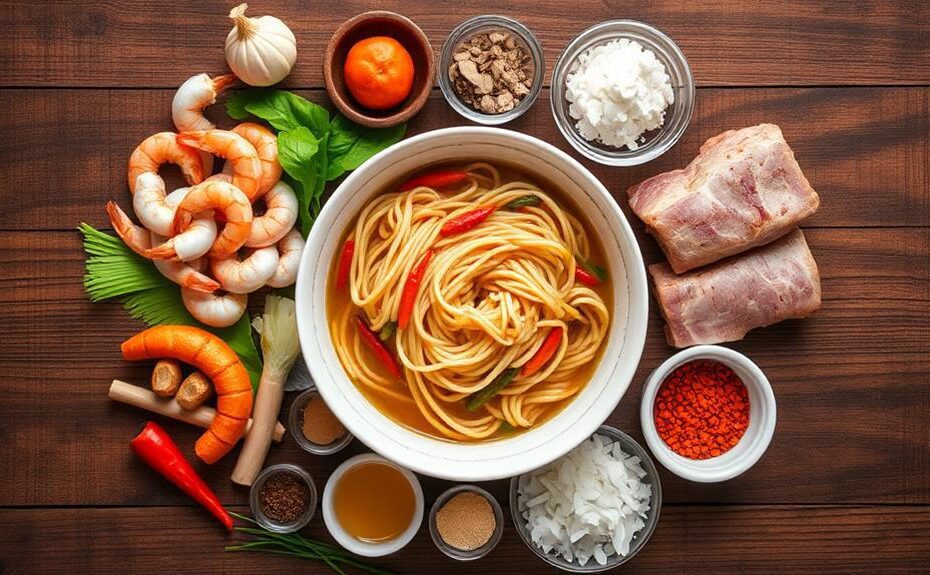Palabok Noodles Ingredients
Base Ingredients: To make Palabok noodles, you need bihon noodles, annatto powder, ground pork, and shrimp. These ingredients form the foundation of the dish.
Flavorful Components: To add texture and flavor, include crushed chicharrón for crunch and hard-boiled egg slices for creaminess.
Palabok Sauce Ingredients: To prepare the signature Palabok sauce, you'll need shrimp stock, sautéed ground pork, garlic, onion, and fish sauce.
Traditional Toppings: Consider adding cooked shrimp, smoked fish, and chopped green onions to elevate your Palabok noodles.
Understanding Pancit Palabok
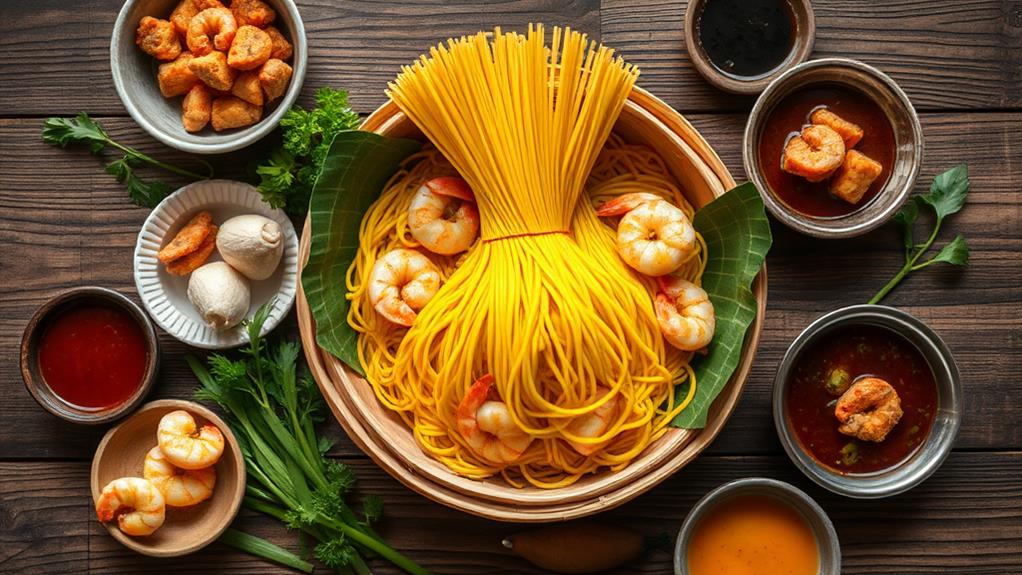
Pancit Palabok: A Culinary Representation of Filipino Culture
When you take a bite of Pancit Palabok, you're experiencing a culinary representation of Filipino culture. This traditional noodle dish is characterized by its rich shrimp and pork sauce, served over thin rice noodles known as bihon.
The key ingredients in Pancit Palabok come together to create a dish that's both hearty and flavorful. Annatto powder adds color, ground pork provides depth, and shrimp adds protein. The sauce is prepared using shrimp stock and pork broth, with a cornstarch slurry to achieve the desired thickness, and is simmered to develop a deep flavor.
Toppings add texture and variety to the dish. Hard-boiled eggs, crushed chicharrón, and smoked fish are common toppings.
With approximately 564 kcal per serving, Pancit Palabok is a nutrient-dense meal that's perfect for celebrations and family gatherings. It's a symbol of hospitality and a reflection of the diverse culinary influences present in Filipino cuisine.
Essential Ingredients for Palabok
Pancit Palabok's Essential Ingredients
The foundation of Pancit Palabok is built on bihon noodles, thin rice noodles that provide the base for the dish.
To give Palabok its signature bright orange color and flavor, annatto powder or annatto water is necessary.
Minced pork and shrimp are key components that add protein and depth to the sauce, combining to create a rich and savory flavor profile.
Some essential toppings to consider are:
Crushed chicharrón (crispy pork rind) for added crunch.
Hard-boiled egg slices for creaminess.
Tinapa flakes for a salty, smoky flavor.
These ingredients will help you create an authentic and delicious Pancit Palabok.
The Palabok Sauce Components
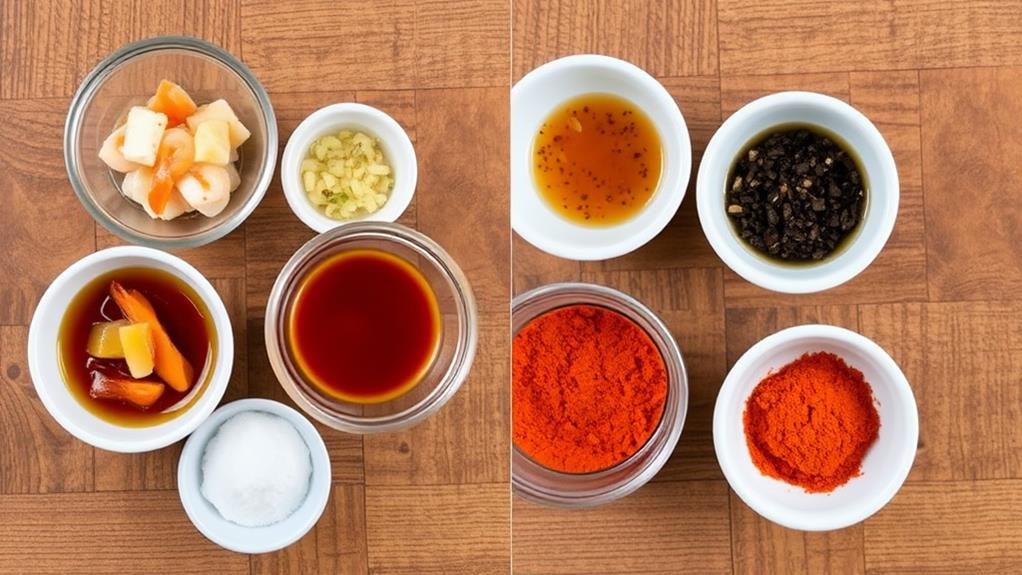
The Palabok sauce is rich and savory due to the combination of its key components.
The first component is a shrimp stock, which is made by boiling shrimp shells and heads to extract their flavorful essence. This stock provides a foundation of seafood flavor to the sauce.
Next, ground pork is sautéed with garlic and onion, adding depth and richness to the sauce.
The addition of annatto powder or annatto water gives the Palabok sauce its distinctive bright yellow-orange color.
A splash of fish sauce (patis) is also essential, as it provides a unique umami flavor that elevates the dish.
Finally, the sauce is thickened with a cornstarch slurry, enhancing its texture before pouring it over the noodles.
By balancing these ingredients, a harmonious blend of savory, sweet, and umami flavors is achieved, making the Palabok noodles truly unforgettable.
Traditional Toppings and Garnishes
Traditional Toppings and Garnishes Elevate Pancit Palabok
To create a well-rounded and delicious Pancit Palabok dish, it's essential to adorn it with traditional toppings and garnishes that complement the rich, savory sauce.
These toppings add flavor, texture, and visual appeal to the dish.
Must-Have Toppings:
- Cooked shrimp, which adds protein and flavor
- Smoked fish, providing a salty and savory element
- Crumbled chicharrón, which adds a satisfying crunch and umami flavor
Balancing Flavors and Textures:
These toppings work together harmoniously, with the smokiness of the fish and the richness of the chicharrón balanced by the freshness of chopped green onions as a final garnish.
Hard-boiled eggs, sliced and arranged on top, contribute a creamy element and additional protein, making the dish more substantial.
Cooking Tips and Variations
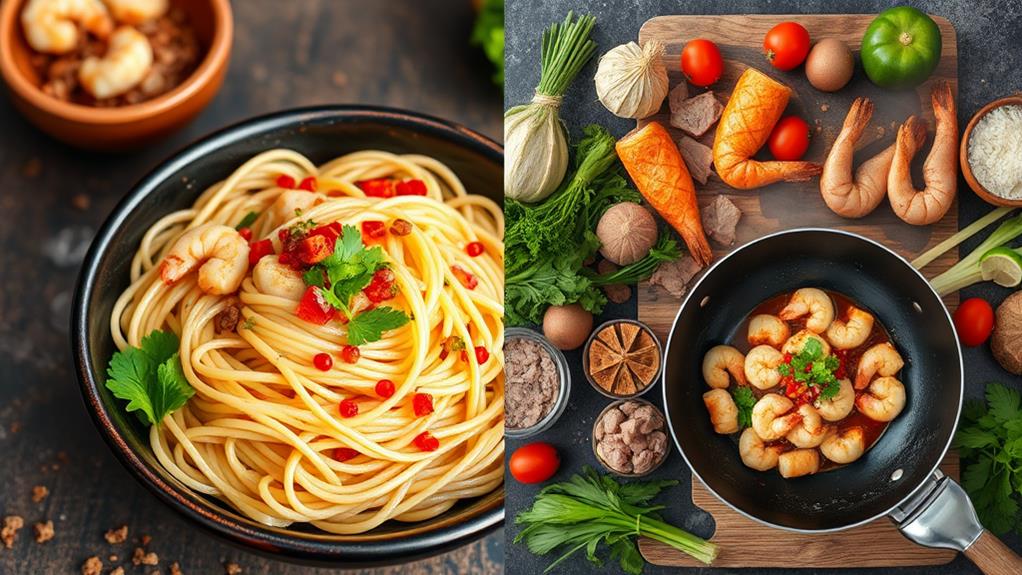
Mastering the Cooking Process
To achieve perfect noodles, soak them in water for at least 30 minutes before cooking to ensure they soften properly and maintain a firm texture when boiled.
Cook them for about 10-15 minutes until they're soft, but be careful not to overcook them to avoid mushiness.
Elevating the Flavor
Use fresh shrimp for the sauce to elevate the flavor of your dish.
Cook shrimp heads in the broth to release natural juices. This will add depth to your Palabok sauce.
Healthier Alternatives
Consider using kelp or shirataki noodles, which are lower in calories and carbohydrates, as a healthier alternative to traditional noodles.
Customizing with Toppings
Experiment with various toppings to customize your Pancit Palabok according to your personal preferences.
Some options include fried tofu, squid rings, or additional vegetables.
Nutritional Information and Facts
Pancit Palabok provides approximately 405 calories per serving, making it a suitable option for energy-packed gatherings.
This dish is a good source of carbohydrates, with 46 grams per serving, which is ideal for active individuals. You'll also get 23 grams of protein primarily from shrimp and pork, supporting muscle health and repair.
The dish contains 15 grams of fat per serving, offering a moderate amount of dietary fat for nutrient absorption.
The sodium content per serving is 1793 mg, which is about 75% of the daily value, suggesting moderation for those monitoring salt intake.
Customizing Your Palabok Experience
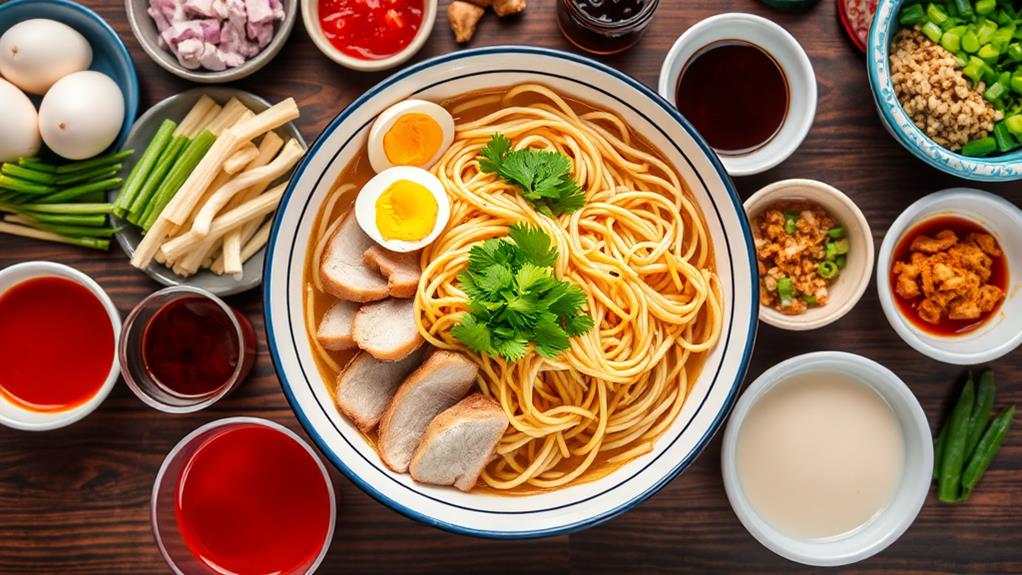
Customizing Your Palabok Experience
To create a unique Palabok dish, make deliberate choices from various customization options. This allows you to tailor the dish to your taste preferences.
Noodle Options
Choose between traditional bihon noodles and cornstarch sticks for a different texture and taste.
Flavor Enhancement
Add Knorr Shrimp Cube or tinapa flakes to deepen the flavor of your Palabok.
Protein Sources
Incorporate boiled pork, shrimp, or fried tofu to add protein to your meal.
Garnish Options
Experiment with crushed chicharrón and chopped scallions for a crunchy texture and fresh flavor.
Sauce Consistency
Adjust the amount of flour mixed with water to achieve your desired sauce thickness.
When customizing your Palabok, mix and match these options to create a unique flavor profile. This allows you to enjoy a dish tailored to your taste buds.
How Can I Use Different Ingredients to Make Palabok Noodles?
Palabok noodles can be made with various ingredients to create different variations of palabok noodles. You can use a combination of rice noodles, shrimp, crushed pork rinds, hard-boiled eggs, and a savory sauce made of stock, fish sauce, and annatto powder. Customize it to your taste with various toppings and flavors.
Exploring Pancit Variations
Pancit Variations
Five Distinct Types of Pancit
There are five popular variations of Pancit dishes, each with unique characteristics that set them apart from one another.
These variations differ in their ingredients, cooking methods, and regional influences, showcasing the diversity and adaptability of Filipino cuisine.
Pancit Malabon
Thick, Tubular Rice Noodles with Seafood Toppings
Pancit Malabon features thick, tubular rice noodles and seafood toppings, combining flavors and textures.
This variation is known for its richness and savory flavors.
Pancit Palabok
Thin Bihon Noodles with Vegetables
Pancit Palabok features thin bihon noodles and a medley of vegetables, representing a classic Filipino comfort food.
Its simplicity and familiar flavors make it a staple in many Filipino households.
Vegetarian Pancit Bihon
Rice Noodles with Vegetables
Vegetarian Pancit Bihon incorporates rice noodles with an assortment of vegetables, providing a plant-based option that's both healthy and delicious.
This variation caters to those with dietary restrictions or preferences.
Regional Influences and Cultural Heritage
Each type of pancit reflects local ingredients and cooking techniques, making every dish a unique representation of its cultural heritage.
Regional variations and interchangeable names add to the diversity of pancit dishes, showcasing the creativity and adaptability of Filipino cuisine.
Frequently Asked Questions
What Are Palabok Noodles Made Of?
Palabok noodles are made from cornstarch, which gives them a distinct texture. This unique composition affects their cooking techniques, requiring a 30-minute soak before boiling.
This is different from other rice noodles, which don't need to be soaked for such a long time.
In traditional recipes like Pancit Palabok, palabok noodles are essential because they absorb flavors from the rich shrimp and pork sauce.
Understanding the ingredients of palabok noodles helps unlock their cultural significance and health benefits as a regional variation.
What Is Palabok Mix Made Of?
A typical Palabok mix consists of a blend of ingredients that reflect the dish's rich history and cultural traditions.
This mix usually includes annatto powder for color, which gives the noodles their distinctive yellow hue.
Pork broth or shrimp stock are added for flavor, providing a rich and savory taste.
Cornstarch or flour are used as thickening agents, helping to achieve the desired consistency.
Additionally, dehydrated shrimp, garlic and onion powder, and fish sauce may be included to enhance the overall flavor of the dish.
This mix serves as the foundation for various Palabok recipes and serving styles, making it a staple in many Filipino occasions and gatherings.
What Are the Ingredients in Super Q Palabok?
Super Q Palabok ingredients include water, cornstarch, and stabilizers.
These ingredients make Super Q Palabok gluten-free and suitable for individuals with dietary restrictions.
What Is Pancit Malabon Sauce Made Of?
Pancit Malabon sauce is a savory condiment originating from the coastal town of Malabon.
It's typically made with a combination of shrimp stock and pork broth, which gives it a rich, meaty flavor.
Ground pork is also a common ingredient, adding depth to the sauce.
Some variations of the sauce may include seafood such as shrimp, squid, and mussels, which further enhance the flavor.
Annatto powder is responsible for the sauce's signature orange color.
